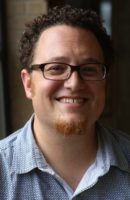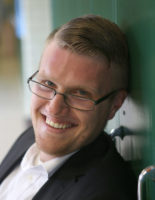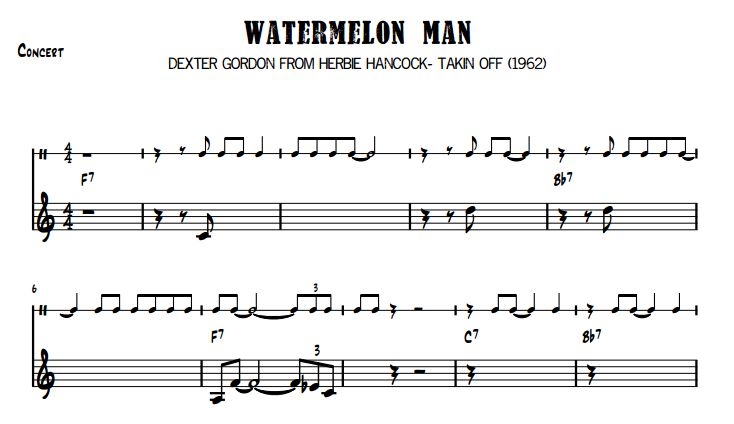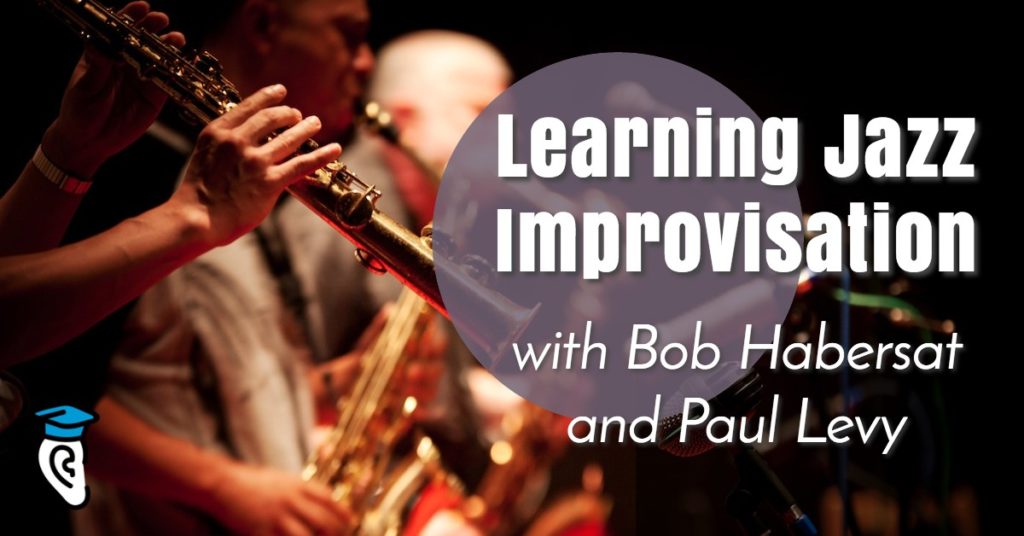How many times have you reminisced with others about high school days? Many have fond memories about the band program: “I used to play clarinet in high school.” But when they graduate, how many of them are ready to play a real-world gig based on their marching band training?
Bob Habersat and Paul Levy, of Oak Lawn Community High School, have teamed up to transform music education based on real-world music skills. In the process they’re teaching students to be lifetime self-learners through innovative web-based curriculum. Then they combine the virtual with the visceral experience of the Chicago live music scene.
Now they’re taking their ideas to the world at The Shed, a new website dedicated to learning music.

Bob and Paul both play out as professional jazz musicians. They’re taking jazz education from the usual playing charts in jazz band to a full-fledged improvisation boot camp. Let’s find out how they’re making jazz real:

Paul Levy
Paul: I come about playing music from a jazz background. From when I first started playing, that was what I wanted to do. My parents took me to jazz shows from when I was 5 years old.
Now, I know Bob did not start with jazz. He was more of a rock guy who came about jazz later. So we blend our two experiences. I grew up listening to it—jazz was in my ear from a very young age. Since Bob, didn’t have it in his ear, he had to think about it from a more technical aspect. I’m more, “How does it feel?” and he’s more, “What does it look like?”
We looked at our own private lesson experience, and at the history of how people learned how to improvise. I remembered taking my lessons, and my teacher was like, “Alright, I want you to write out a solo on this song, these chord progressions.” I’d literally have to write out, “Improvised Solo,” and memorize it. He was like, “Good. Nobody knows that you didn’t make that up.”
Then I read an article about a high school jazz festival judge. He was less than awed at the inability of young kids to improvise. He was like, “I would rather they write it out, and figure out what they’re going to play—before they play it. I don’t want to listen to five hours of terrible solos.”
Then a light bulb went off. Improvisation is spontaneous composition, but no one spontaneously improvises in the beginning—it sounds terrible. So we’re going to start with the composition part and work our way into the spontaneity.

Bob Habersat
Paul: We have come up with a couple of ideas to approach that, starting with simple melodies. Play two-note melodies, and improvise with the students with call-and-response. We both are players, so we do a ton of playing with the kids. I always have my horn with me the whole time, and I know Bob has his guitar.
The fear with improvisation comes with not knowing what to play, and not being forced to do it. It’s a really scary thing, and it’s really personal. A kid doesn’t know what to do, and the teacher says, “Well, just play these five notes” It sounds simple but you’ve never done it. It’s very intimidating.
This is how I eliminate the fear: if you’re in jazz, you’re improvising. There is no other choice. I spend a portion of rehearsal making everyone improvise. It is a huge foundation of the music. Jazz is improvisation-based. It’s not coming from the classical tradition of, “This is the written tune, this is what you play.”
Paul: We begin with internalization. Think about language acquisition. All you’re doing is mimicking. You write out your solo and now you’re going to figure out, “Okay, that doesn’t work. What works? Why does that work?” Combine it with that music theory aspect: “Oh, that works because it’s related to this chord in this way.”
Then it becomes vocabulary, so how can we find authentic vocabulary? Through transcription. Transcription is the hardest thing in the world to do as a young musician. You listen to a Coltrane solo, and it’s like, “Write that out? What?”
So we start small. We do a lot of transcription on our own, finding out jazz phrases from particular recordings, something we call Language of the Legends. It’s like, “Okay, this lick works over these things.” It’s that classic lick acquisition, but we’re incorporating that pre-written element, and practice until you internalize it. Now you know, “When I see a ii-V in C major, I have a library of things to do.”
Bob: We teach them how to analyze a tune. Where are the ii-V‘s? Where are dominant cycles? Then they have a huge resource of ii-V‘s that they can use. Then they use these licks to write out a solo.
Let’s say they identify a ii-V in F, and then they plug in a lick from the Language of the Legends resource. Then they can say, “That was Sonny Rollins, that was in this recording.” Then, “If I change this one note, it’s going to sound a little different.” Then we get into outlining chords, how to do bebop ornamentation, and eventually they’re writing their own licks. Eventually, they’re transcribing their own licks, which is cool.
For example, I really dig Kurt Rosenwinkel’s solo on 26-2. Listen at [2:32]:
What is he doing in this or that measure? Step by step, we’re going to teach a kid who could transcribe that.
Bob: Rhythm is by far the hardest part about transcription. So we created this guided transcription to help learn the steps and build confidence. The guided transcription has the rhythm on top, and then some helper notes, so that they have a starting place.

Guided Transcription Example from The Shed. Here are the complete pdfs and audio.
We work on transcribing rhythm separately with focused exercises. On my rhythm guide page, I have a bunch of recordings of just me talking in rhythm to a metronome. I say weird, off the wall things—the kids get a kick out of it. One of the assignments is to transcribe the rhythm that I’m saying.
They get better at transcribing rhythm, and then eventually they’ll be able to put rhythm and pitches together. I had three guitar kids last year that were just transcribing like crazy. They really got into gypsy jazz, for some reason. When they played, they sounded good. They had the style, they had the vocabulary. Now that they’ve had success in that, they’re more likely to go out on their own, and listen.
Listening is the biggest thing. And the key to real success.
Paul: Improvisation at its core is not mysterious. It’s this myth of improvisation, “I’ll just make it up, man.” Nobody does that in reality. Every jazz musician, for the entire history of jazz, and every improvisational musician, regardless of style, has worked out the stuff. No one is totally spontaneously composing. Clark Terry has a whole creative process, “Imitate. Assimilate. Create.”
You can’t get to the create until you imitate. If I can get my kids to imitate really well, they’re well on their way. This is not something that I even think that a majority of kids can get in their four years of high school. I’ve been playing music for quite a long time, and I still don’t think I’m really at the create stage. I don’t even think Sonny Rollins would say that he is—and he’s probably one of the greatest living improvisers. It’s just giving them tools, and letting them run with it.
Paul: Yes. We haven’t ever seen it codified in this way. With an eye on the future, you have to do it research based. We follow our students, and we had two kids in particular that really opened up their eyes to, “Oh, this is real jazz improvisation.” They started to go out to jam sessions. Now they’re both in college for jazz studies, and they both got a huge amount of scholarship money for it.
Putting Transcription to Work
Transcription has always been a mainstay for jazz pros. Combining transcription with guided learning and using the lessons learned immediately in your playing, Bob and Paul are taking it up to the next level by breaking it down and teaching it’s real world applications in your playing.
Bob Habersat and Paul Levy cut to the quick of jazz learning with their step-by-step process of learning improvisation. And it’s not just for the lucky few at Oak Lawn Community High School: boost your jazz language skills with all the tools at the ever-growing jazz portion of The Shed.







